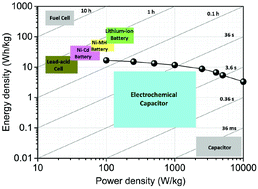Highly porous graphitic biomass carbon as advanced electrode materials for supercapacitors†
Abstract
In this work, we established a one-step strategy to synthesize three-dimensional porous graphitic biomass carbon (PGBC) from bamboo char (BC), and studied its electrochemical performance as electrode materials for supercapacitors. Using potassium ferrate (K2FeO4) to fulfil the synchronous carbonization and graphitization of bamboo carbon, this method is less time-demanding, highly efficient and pollution-free, when compared with a conventional two-step strategy. The as-prepared PGBC sample possessed a porous structure with a large specific surface area (1732 m2 g−1) and abundant micropores, as well as a high graphitization degree demonstrated by XRD and Raman. Further electrochemical measurements revealed that the PGBC electrode exhibited a high specific capacitance of 222.0 F g−1 at 0.5 A g−1, and the solid-state symmetric supercapacitor in an aqueous electrolyte (KOH/PVA) presented considerable synergetic energy–power output properties with an energy density of 6.68 W h kg−1 at a power density of 100.2 W kg−1, and 3.33 W h kg−1 at 10 kW kg−1. Moreover, the coin-type symmetric supercapacitor in an ionic liquid electrolyte (EMIM TFSI) delivered a higher energy density of 20.6 W h kg−1 at a power density of 12 kW kg−1. This approach holds great promise to achieve low-cost, green and industrial-grade production of renewable biomass-derived carbon materials for advanced energy storage applications in the future.



 Please wait while we load your content...
Please wait while we load your content...